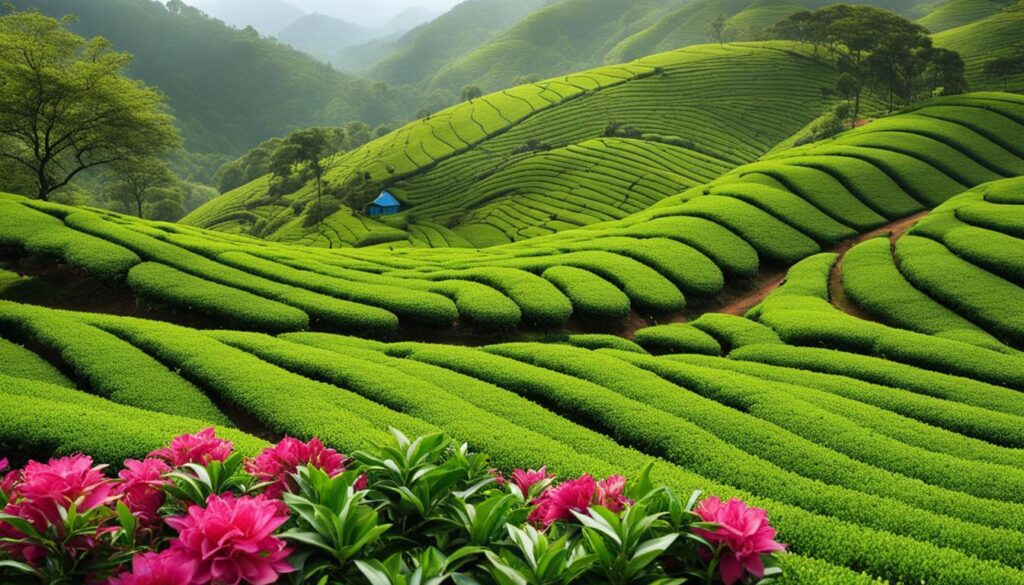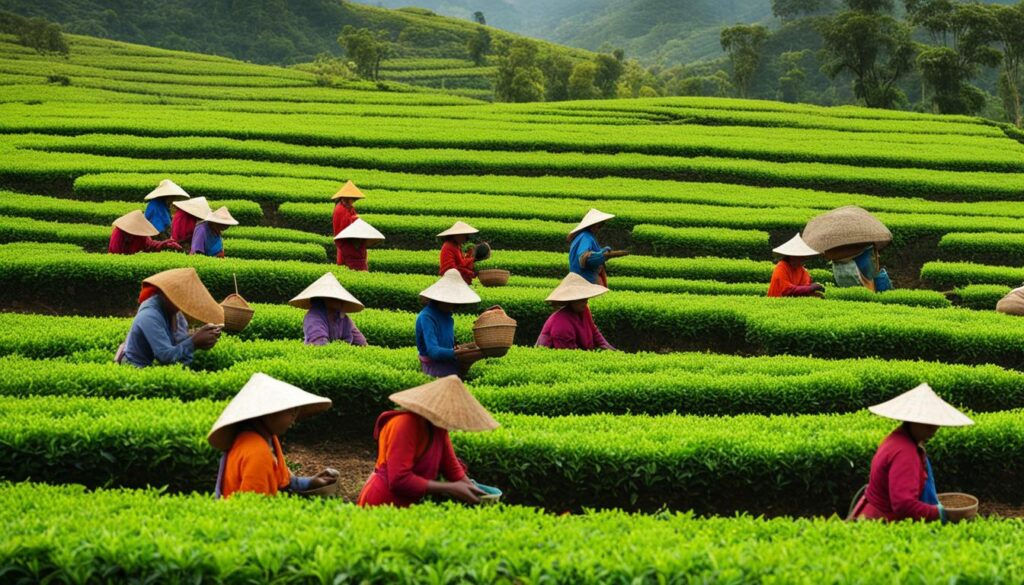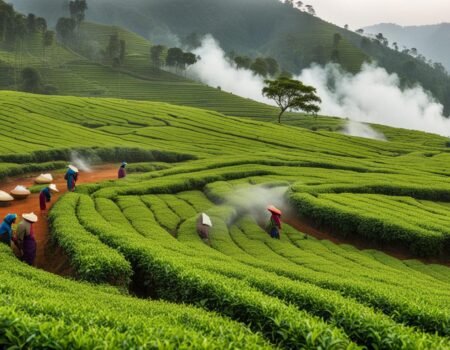
Understanding Seasonal Tea Harvesting in Different Regions
As tea lovers, we embark on a journey to explore the vast world of tea. From the delicate green teas of Japan to the robust black teas of India, each cup tells a unique story. But have you ever wondered how the time of year impacts the flavors and quality of your favorite brew? Join us as we delve into the captivating realm of seasonal tea harvesting in different regions.
Key Takeaways:
- The harvest date of a tea greatly influences its flavor and quality.
- Different tea styles have distinct harvest seasons, each offering unique characteristics.
- Spring teas, such as green, white, and oolong, are cherished for their naturally sweet flavors.
- Summer teas are often used as a base for blends or flavored teas.
- Fall teas are considered respectable and can vary in quality across regions.
Spring Harvest (March – May)
Spring is a season of new beginnings, and in the world of tea, it brings forth the most sought-after harvest of the year. The spring harvest, also known as the first flush, takes place from March to May and yields teas with exceptional quality and unique flavors.
During this time, tea leaves are plucked when they are young and tender, just after winter dormancy. These young leaves and buds are bursting with nutrients, resulting in teas that are vibrant, aromatic, and full of flavor. The cool weather and dewy mornings during spring contribute to the development of complex flavor profiles in the teas.
One of the highlights of the spring harvest is the picking of the delicate tea buds, also known as “spring buds.” These buds are highly prized for their sweet and delicate taste, making them ideal for producing high-quality teas. Green and white teas, such as Bai Hao Yin Zhen (Silver Needle) and Long Jing (Dragon Well), are best harvested during this season to capture their fresh and naturally sweet flavors.
Spring Tea Varieties
- Green teas: Known for their freshness and grassy notes, spring-harvested green teas are highly regarded for their crisp, vegetal flavors.
- White teas: Delicate and subtly sweet, white teas harvested in the spring offer a light and refreshing experience.
- Oolong teas: From the floral and aromatic Tie Guan Yin to the rich and creamy Ali Shan, oolong teas harvested in the spring exhibit an array of flavors.
- Black teas: Black teas made with spring buds possess a unique sweetness and maltiness, creating a distinct flavor profile.
The spring harvest is a time when tea enthusiasts eagerly await the arrival of the new crop, as it offers an opportunity to savor the terroir of the season and experience the finest teas the year has to offer. Whether you prefer the delicate sweetness of white tea or the vibrant flavors of green tea, the spring harvest never fails to deliver teas that are truly exceptional.
| Tea Variety | Flavor Profile | Notable Spring Teas |
|---|---|---|
| Green Tea | Fresh, grassy, vegetal | Long Jing (Dragon Well), Bi Luo Chun, Mao Feng |
| White Tea | Delicate, subtly sweet | Silver Needle, White Peony, Shou Mei |
| Oolong Tea | Floral, aromatic, creamy | Tie Guan Yin, Ali Shan, Dong Ding |
| Black Tea | Sweet, malty | Golden Monkey, Yunnan Gold, Keemun |
Experience the essence of spring in every sip with these exquisite teas harvested during the first flush. Indulge in the flavors of the season and embark on a tea journey that captures the freshness and beauty of spring.

Summer Harvest (June – August)
As we enter the summer months, tea plants experience rapid growth, leading to increased production during the summer harvest. This abundance of tea leaves is often used in the production of mass-produced teas, which are commonly used as a base for blends or flavored teas due to their larger quantities and lower prices.
Black teas grown in the summer are particularly popular for use in tea bags or loose leaf blends, as their robust flavors can withstand the addition of other ingredients. These teas are known for their bold and full-bodied profiles, making them a favorite among tea lovers who enjoy a stronger brew.
It’s worth noting that the increased growth rate during the summer can result in higher caffeine content in the tea leaves. While caffeine is naturally present in tea, the elevated levels in summer harvests can contribute to a slightly more bitter and astringent taste. However, many tea enthusiasts appreciate the invigorating effect of these teas and enjoy the nuanced flavors they offer.
The Role of Summer Teas in the Tea Industry
Summer harvests play a crucial role in meeting the high demand for tea worldwide. The abundance of tea leaves allows for large-scale production, making it possible to supply tea to a broad consumer base. Additionally, summer teas provide opportunities for tea blenders to experiment with flavors and create new and exciting blends.
While summer teas may not have the same level of complexity and delicacy as other seasonal harvests, they offer a more affordable option for tea enthusiasts who enjoy experimenting with different flavors. These teas provide a versatile base for adding natural flavors, such as fruits or herbs, resulting in a wide variety of flavored teas available in the market.
In conclusion, the summer harvest brings forth a bountiful supply of tea leaves, catering to the mass production of teas and the creation of flavored blends. While these teas may have stronger flavors and slightly higher caffeine content, their affordability and versatility make them a popular choice among tea lovers around the world.
Fall Harvest (September – November)
As the summer heat begins to wane and the leaves start to change color, tea lovers eagerly anticipate the arrival of the fall harvest. The fall season brings a new wave of flavors and characteristics to the world of tea, offering a unique experience for enthusiasts to savor. Fall teas are considered respectable in many tea growing regions, and the qualitative differences between spring and autumn harvests can vary.
Secondary Harvest
In some regions, such as Guangdong, Fujian, and Taiwan, oolong teas have a secondary harvest in the fall. This secondary harvest often yields teas with a richer, creamier texture and unique flavor profiles. Taiwanese oolongs harvested in October or November are even referred to as “Winter” teas, showcasing their special characteristics and setting them apart from other teas harvested during the year.
“Fall teas are like a symphony of flavors, showcasing the maturity and depth that comes with the changing of seasons. From the earthy notes of fallen leaves to the subtle sweetness of ripe fruit, autumn teas are a true delight for the senses.” – Tea connoisseur
While fall teas may not have the same level of sweetness as spring teas, they offer a more complex and robust flavor profile. The changing weather conditions and the natural progression of the tea plants contribute to the distinctive characteristics of fall teas. Whether it’s a rich oolong or a smooth black tea, fall harvests are cherished for their unique taste and the sense of anticipation they bring to tea enthusiasts around the world.

| Tea Type | Taste | Characteristics |
|---|---|---|
| Oolong | Rich, creamy | Distinct flavors, smooth texture |
| Black | Robust | Full-bodied, malty notes |
| Pu-erh | Earthy, mellow | Aged, fermented flavors |
| Herbal | Varies by blend | Warm, comforting |
With each passing season, the world of tea unfolds new surprises and delights. Fall harvests bring their own unique flavors and characteristics, offering tea aficionados a chance to experience the changing terroir and the artistry of tea cultivation. So, as the leaves fall and the air turns crisp, let’s raise our cups to the fall harvest and savor the distinctive taste of autumn in every sip.
Winter Harvest (December – February)
The winter season brings a unique opportunity for tea harvesting, as tea plants in China enter a dormant period during the coldest months. However, in warmer latitudes like Taiwan, tea plants can experience unseasonably warm weather and produce teas during the winter. These winter harvests, also known as “dong pian” or “winter sprout,” are highly sought after for their exceptional sweetness.
The cold weather causes the tea plants to slow down their growth, resulting in a concentrated flavor profile. The leaves are usually picked during the winter months when they are still young and tender, maximizing their sweetness and complexity. The cold weather also contributes to the development of unique flavors and aromas in the tea.
In Taiwan, winter teas are different from teas harvested during other seasons. They are known for their smooth texture, rich fragrance, and honey-like sweetness. The flavors can range from floral and fruity to nutty and creamy, offering a delightful sensory experience.
Overall, winter teas are cherished by tea enthusiasts for their exceptional quality and limited availability. They provide a refreshing and comforting cup of tea during the colder months, allowing us to appreciate the diversity and versatility of tea throughout the year.
| Winter Tea | Flavor Profile | Aroma | Texture |
|---|---|---|---|
| Taiwanese Winter Oolong | Rich, creamy, floral, fruity | Pronounced, fragrant | Smooth, velvety |
| Chinese Winter Black | Malty, chocolaty, earthy | Intense, lingering | Robust, full-bodied |
| Winter Green Tea | Grassy, vegetal, subtle sweetness | Fresh, delicate | Crisp, clean |
Conclusion
Tea Harvest Calendar: Unlocking the Secrets of Seasonal Variations in Tea Quality
As tea enthusiasts, we know that the harvest date of a tea plays a significant role in the flavor profile and overall quality of the brew. Each tea style has its distinct harvest season, offering a unique experience for our taste buds.
From the sweet and delicate flavors of spring teas like green, white, and oolong, to the mass-produced summer teas commonly used as a base for flavored blends, and the respectable fall teas with varying qualitative differences, each season delivers something special.
Knowing the specific harvest seasons for different regions and types of tea allows us to embark on an exciting journey to find the perfect cuppa. Whether it’s capturing the terroir of the spring buds or indulging in the sweetest winter sprout teas, the tea harvest calendar offers a roadmap to our tea adventures.
So, let’s embrace the changing seasons, eagerly awaiting the first leaves of the new crop year. As tea lovers, we understand that each harvest is an opportunity to savor the variations in flavors and celebrate the magic of tea.
FAQ
How does the harvest date of a tea influence its flavor and quality?
The harvest date of a tea plays a big role in the flavor of the finished brew. Different harvest seasons offer unique flavors and characteristics.
What are the different harvest seasons for tea?
There are specific harvest seasons for different regions and types of tea. These include spring, summer, fall, and winter.
What is special about spring teas?
Spring teas, such as green, white, and oolong teas, are often desirable for their naturally sweet flavors. Spring harvests are known for their high quality and desirable flavors.
What can I expect from summer teas?
Summer teas may have less complex flavors and are often used as a base for flavored teas or blends. Black teas grown in the summer are commonly used in tea bags or loose leaf blends.
Are fall teas considered high quality?
Fall teas are considered respectable in many tea growing regions, and the qualitative differences can vary. Oolong teas from Guangdong, Fujian, and Taiwan have a secondary harvest in the fall.
What makes winter teas unique?
Tea plants in China enter a dormant period during the coldest months. However, in warmer latitudes like Taiwan, teas can be harvested during the winter. Winter teas, harvested in Taiwan during unseasonably warm weather, are the sweetest of the year.
How can knowing the harvest season help me find the perfect tea?
Knowing the harvest season can help in the search for the perfect tea, as different seasons offer unique flavors and characteristics. Tea lovers eagerly await the first leaves of the new crop year, marking the beginning of spring and a chance to capture the terroir of the season.
Are there any tea regions that have specific harvest seasons?
Yes, different regions have specific harvest seasons. For example, oolong teas from Taiwan and tea plants in China have distinct spring and fall harvests.
Are there any teas that are best picked early in the spring?
Minimally processed green and white teas are best picked early in the spring for the sweetest flavors. Oolong teas from Taiwan are also harvested in the spring and tend to be aromatic.






